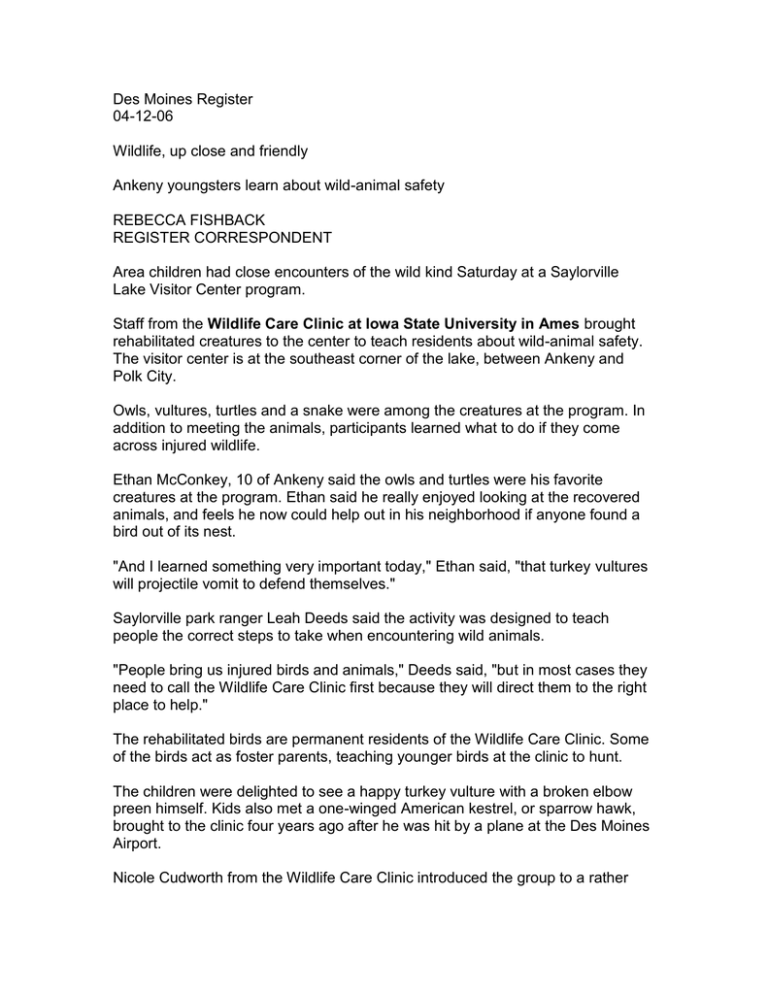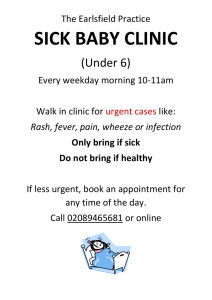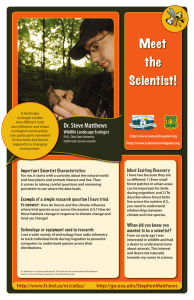Des Moines Register 04-12-06 Wildlife, up close and friendly
advertisement

Des Moines Register 04-12-06 Wildlife, up close and friendly Ankeny youngsters learn about wild-animal safety REBECCA FISHBACK REGISTER CORRESPONDENT Area children had close encounters of the wild kind Saturday at a Saylorville Lake Visitor Center program. Staff from the Wildlife Care Clinic at Iowa State University in Ames brought rehabilitated creatures to the center to teach residents about wild-animal safety. The visitor center is at the southeast corner of the lake, between Ankeny and Polk City. Owls, vultures, turtles and a snake were among the creatures at the program. In addition to meeting the animals, participants learned what to do if they come across injured wildlife. Ethan McConkey, 10 of Ankeny said the owls and turtles were his favorite creatures at the program. Ethan said he really enjoyed looking at the recovered animals, and feels he now could help out in his neighborhood if anyone found a bird out of its nest. "And I learned something very important today," Ethan said, "that turkey vultures will projectile vomit to defend themselves." Saylorville park ranger Leah Deeds said the activity was designed to teach people the correct steps to take when encountering wild animals. "People bring us injured birds and animals," Deeds said, "but in most cases they need to call the Wildlife Care Clinic first because they will direct them to the right place to help." The rehabilitated birds are permanent residents of the Wildlife Care Clinic. Some of the birds act as foster parents, teaching younger birds at the clinic to hunt. The children were delighted to see a happy turkey vulture with a broken elbow preen himself. Kids also met a one-winged American kestrel, or sparrow hawk, brought to the clinic four years ago after he was hit by a plane at the Des Moines Airport. Nicole Cudworth from the Wildlife Care Clinic introduced the group to a rather grumpy looking red-tailed hawk with a wing droop; and a petite, partially blind Eastern screech owl. Also appearing were a barred owl and a large great horned owl, both with partially amputated wings. Children laughed as the wide-eyed owls showed off, turning their heads almost all the way around or sitting stiff-necked as the rest of their bodies moved up and down, demonstrating their ability to hone in on prey. Hannah McConkey, 6, from Ankeny grinned ear to ear. Hannah said she was excited because she had never seen a turkey vulture before. "I really like all the animals," Hannah said, "all of them." Cudworth said many raptor birds get hit by vehicles because drivers throw bits of food out of their windows. "The rodents and birds will gather along the road and eat these leftovers," Cudworth said, "and since these animals are prey for the raptors, the birds will swoop down to eat them." When the raptor birds approach the road, Cudworth said, they only see their prey and not the vehicles. Cudworth told the children, "If you take anything away from this, remember to never throw food outside of your car when you're driving." Young participants watched with trepidation - a few leaving their front-row seats as Saylorville park ranger Amy Cline tightly held a large, rather aggressive bull snake that is recovering from being run over by a vehicle. Cline also showed off two softball-sized ornate box turtles. She told the children to always be cautious around wild animals since even a cute-looking turtle can bite hard with its very sharp beak. Hope Navin, 10, from Ankeny said she's participated in a junior ranger program and feels she already knows a lot about wild animals. Hope said she has a special passion for red-tailed hawks. "I have a red-tailed hawk in my backyard," she said, "so he was my favorite to see here today." Jim and Pat Lynch from Grundy Center brought their grandchildren to the program. "We hoped the kids would learn something," Jim Lynch said, "and it's turned out to be very fun." Learn what to do if you find an animal Sarah Scheel, from the Wildlife Care Clinic, said that the most common questions asked this time of year are about baby animals. “If you find a baby bird, a baby bunny, or any kind of baby animal, the first thing you need to do is make sure they are really orphaned or in danger," Scheel said Saturday. Scheel said that if a baby bird doesn’t have feathers yet, residents should try to put it back into its nest since the mother probably won’t care for a baby out of the nest. If the bird does have feathers, she said, it’s probably just learning how to fly — but people can try to protect it from predators, such as neighborhood cats or dogs. Mother rabbits only check on their babies at dusk and dawn, Scheel said. Put a little string over the rabbit nest, she said, and wait a couple of feeding cycles. If the string is never disturbed, the bunnies probably have been abandoned. Some small rabbits are able to care for themselves, Scheel said. “If a bunny has its eyes open, they’re alright to be on their own." A mother squirrel will not take care of a baby out of the nest — so if residents happen to find one that has fallen from its home, they can try to get the little squirrel back to the nest. If the nest is out of reach, residents should call the Wildlife Care Clinic as soon as possible. Sometimes a mother opossum will drop one of her youngsters, but Scheel said officials never encourage anyone to help those babies because in most cases the mother will come back and retrieve it. “We tell people to always try and let the natural parents take care of their young, because we are no substitute for the real mom,” Scheel said. The Wildlife Care Clinic is part of the college of veterinary medicine at Iowa State University. Experts there work with the Department of Natural Resources to help injured animals. — Rebecca Fishback






